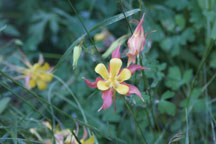
You may have read that when the first Mormon immigrants arrived in the Salt Lake valley, they found few trees growing here. Not true, according to Sandy resident Ty Harrison. When his ancestor John Thomas Wilson homesteaded 80 acres on the Jordan River, there were great numbers of narrowleaf cottonwood, box elder and peachleaf willow trees along the creeks that flowed from the foothills to the river.
Today, five acres of the Harrison Farm are part of the 120-acre Jordan River Migratory Bird Reserve. Since 1997, Dr. Harrison, a retired professor of biology at Westminster College, has worked with various private and governmental agencies to preserve and restore the wildlife habitat in the floodplain.
However, even before he made his family farm a part of the Refuge, Harrison helped to create a smaller but equally important restoration project in Sugar House.
According to Harrison, Hidden Hollow Natural Area is the oldest and most successful riparian restoration project in Salt Lake City. Seven different “naturescapes,” as Harrison describes them, represent the plant communities that are found along Parley’s Creek as it descends from the eastern foothills to the valley floor. Each is planted with trees, wildflowers and grasses that grow naturally at different elevations on the Wasatch Front. The natural area requires little maintenance beyond annual mowing and pruning, and minimum irrigation once the plants mature.
Dr. Harrison hopes that Hidden Hollow will show people how to improve their own yards using native species. Plants such as chokecherry and Gambel oak provide food and shelter for wildlife. Harrison said the trees in Hidden Hollow are nest sites for birds such as the Bullock’s oriole, which will raise its babies there before migrating back to Central America in the fall. Native plants are also more fire-resistant than introduced species. After a fire in Hidden Hollow several years ago, it took only one season for the willows, Fremont cottonwoods and native shrubs to recover.
Hidden Hollow is used primarily as an outdoor classroom for teaching students about Utah’s native plants, birds and animals. It is protected by a conservation easement and it is the venue for the annual Hidden Hollow Conservation in Concert Series.
This year, construction of the pedestrian tunnel under 1300 East will make Hidden Hollow a little less hidden. It will be a great time to see this remnant of the old West, listen to the songs of native birds, and hear some contemporary western music. §
For information on the Hidden Hollow Conservation in Concert series, visit http://www.utahopenlands.org/



